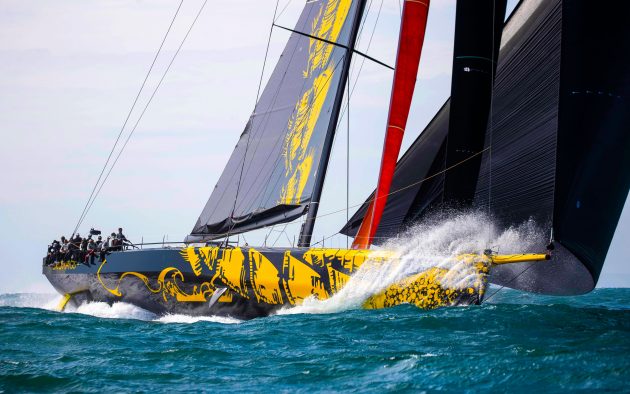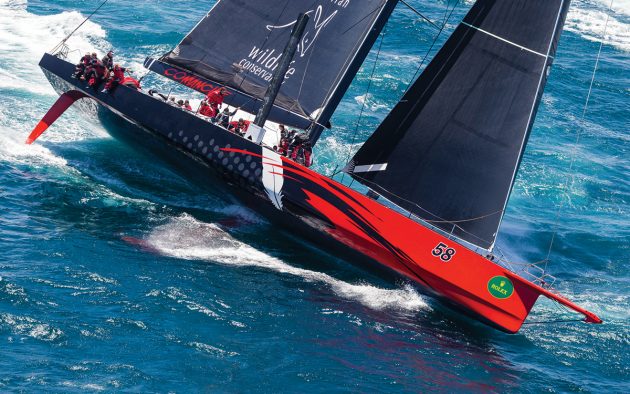Skorpios is the latest in a long list of giant monohulls designed with a view to becoming the fastest yacht on the planet. We take a look at some of her predecessors
Every so often the yacht racing world sees an ambitious owner with pockets deep enough to want to step things up a gear and produce a new record-smashing fastest yacht.
The latest of these to hit the water is the jaw-dropping ClubSwan 125 Skorpios built for its Russian owner, Dmitry Rybolovlev. Almost everything about this new monster yacht is bigger, stronger, faster and higher tech than any boat which came before it.
Pretty much any metric you care to look at on Skorpios is mind-boggling. The five-spreader Southern Spars mast stands at 175 feet tall, and she can carry 11,324 square feet of sail upwind, and 21,108 square feet downwind.

Enough sail? Skorpios off the Dorset coast. The ClubSwan 125 is named after owner Rybolovlev’s famous Greek island, where Jackie Kennedy married Aristotle Onassis. Photo: Mark Lloyd / Lloyd Images
Skorpios has been built with the express brief to break offshore records as the world’s fastest yacht. Her recent win in the 2021 Fastnet Race – only weeks after hitting the water for the first time – shows she certainly has what it takes to take line honours in big races.
And the numbers Skorpios has shown while racing initially seem to indicate that it is really only a matter of time until she starts claiming some of the biggest records on offer in the sailing world.
 Watch the video
Watch the videoBut Skorpios is only the latest in a long line of new yachts built with the express purpose of winning line honours and taking records, each bigger, faster and more technologically advanced than that which came before.
Comanche
The current transatlantic record holder, Comanche, is probably the yacht that most readily springs to mind when we’re looking at the development path for Skorpios.
Before Skorpios, Comanche was the most recent, highly ambitious racing yacht on the planet. She was built with one thing in mind and one thing only, to break ocean records and win line honours in some of the world’s most famous races.

Comanche showing off her considerable beam. Photo: Carlo Borlenghi
“The design office were told specifically by me that if this boat wasn’t the worst rated boat in history they have failed,” stated the owner Jim Clark on Maxi, Comanche’s launch, reaffirming the aim of the boat to break records and win line honours without any consideration for handicap wins.
Comanche was something of a revelation when she was first launched. Over the years boats had been carrying more beam (width) towards the transom to create more power – at the expense of outright light weather, upwind and VMG running performance.
Comanche took this line of thought to the extreme with what seemed an impossibly wide stern, which led to the boat being nicknamed the aircraft carrier.
Although Skorpios is technically beamier than Comanche (8.75m vs 7.85m) the ClubSwan’s hull shape has a more modest beam-to-length ratio, and far greater internal volume and higher freeboard, all products of the project starting out with some focus on cruising in addition to outright performance.
But despite a slightly less powerful hull shape compared to Comanche, when you look at the rig, you see that this will likely be overcome by sheer grunt in terms of sail area. Skorpios’ mainsail alone is 7,093 square feet, compared to Comanche’s 4,413 square feet.
Comanche was, indeed is, a yacht that pushed technology to the absolute limit and when she was launched her extreme design caused quite a stir.
She is still considered one of the fastest yachts on the face of the earth and, in addition to her transatlantic record, Comanche also holds the monohull 24 hour sailing record at an impressive 618.01nm (averaging 25.75 knots) in a 24 hour period.
These two records will almost certainly be two of the key prize scalps Skorpios will be hoping to take.
Mari Cha IV
Although for many Comanche is the most obvious boat to which Skorpios can be compared, arguably a closer comparison could be that of Mari Cha IV, particularly when you consider length and ambition to break oceanic records.
The 140ft Mari Cha IV was launched in 2003, at this size both Mari Cha IV and (140ft) Skorpios face a similar problem, there are several top races that have an upper LOA limit of 100ft – neither could take part in the Sydney Hobart race for example.

Mari-Cha IV held the Atlantic record for 12 years. Photo: Thierry Martinez
In 2003, Mari-Cha IV set a new west-east transatlantic record with a total time of 6 days, 17 hours. During the run, she also set a new 24 hour monohull distance record of 525.5 nautical miles. This record stood until Comanche snatched the crown in 2016.
Due to her size and the sail area needed to power the giant, Mari Cha IV was built as a two-masted schooner. This meant that each mast could be smaller – within the bounds of the technology available at the time.
The twin rig on Mari Cha IV also meant each of the sails could be smaller than would be needed on a single masted yacht, reducing loads and enabling the boat to be sailed without resorting to powered winches.
That Skorpios is a single masted 140 footer demonstrates two things. The ClubSwan 125 shows the advances in technology with a single 175ft mast now being much more easily managed and understood – thanks, in no small part to advancements in load sensing technology which have filtered down from the America’s Cup and high tech offshore yachts such as the Ultime trimaran and IMOCA 60 fleets.
However, sail handling for sails of the size needed on Skorpios is still an issue and the ClubSwan 125 still needs powered winches, which will put her out of contention for a number of records that require exclusively human power.
Speedboat
In 2008, Speedboat was launched. The Juan Kouyoumdjian-designed 100ft Maxi was a yacht designed to produce blistering speeds and was built with the express purpose of ocean record breaking.

Speedboat, Newport Bermuda Race 2010
The yacht was built by Mick Cookson at Cookson Boats in New Zealand and her radical underwater features, including an incredibly flat run aft were all features that would later be included in the design of Comanche – features that demonstrate a yacht built for record breaking as they offer serious compromises in lighter winds.
In many respects Speedboat was the first to take the wide flat hull concept and transplant it wholesale into a 100ft Maxi.
Speedboat was also the first Maxi to have a deck-stepped rig, which was produced by Southern Spars, and she has plenty of other radical features.
To an extent Speedboat was built as a scaled up version of the Volvo 70’s which had been impressing in the Volvo Ocean Race. As such it is hardly a surprise the boat was the product of Kouyoumdjian’s design house, as he had created several of the fastest Volvo 70s then racing.
Unfortunately Speedboat arrived at the very start of the financial crisis and she only sailed in a number of events before she was mothballed and eventually sold.
She went through a couple of incarnations before being purchased by George David and was sailed as Rambler 100 during which time she dramatically lost her keel and capsized while competing in the Fastnet Race.
For his part David would go on to commission Kouyoumdjian to draw Rambler 88, an impressive bit of kit in its own right and aimed at winning line honours and races outright in an 88ft package.
Wild Oats XI
No list of record breakers and record holders would be complete without a mention of Wild Oats XI, the 100 ft Maxi belonging to the Oatley family, which has won the Sydney Hobart no less than seven times.
Wild Oats XI (WOXI for short) was actually launched back in 2005 and is a prime example of what can be done to a yacht to keep her on pace with current trends and developments.
In 2009 she was lengthened at bow and stern from 98ft to 100ft. In 2011 her forward balanced spade canard was removed and twin daggerboards were added amidships. In 2012 she received a bow centreboard as well as caudal fin winglets on her torpedo bulb.

Wild Oats XI. Photo: Kurt Arigo / Rolex
In 2013 she was equipped with a Dynamic Stability System (DSS) foil, which is a retractable horizontal foil deployed on the leeward side of the boat.
In 2015 her stern was shortened by 2m and her 12m forward sections were replaced by a 14m longer, sleeker bow, keeping her midship sections unmodified and in effect moving her entire existing sailplan aft by 2m, a trend which had been seen in many of the newer maxis to be produced since.
The various appendages which have been added and removed over the years have lent the yacht the affectionate nickname the ‘Swiss army knife’.
By today’s standards WOXI remains a very skinny boat in the Maxi world – she and almost-sistership at the time of launch, Alfa Romeo II both had a max beam of a little over 5m.
Wild Oats XI remains a potent race boat and particularly for races like the Sydney Hobart, her relatively narrow beam gives her an edge in light winds, VMG running and beating, all of which mean she is still very hard to beat over a race with mixed conditions – if ultimately working against her should she ever look to set oceanic records.
Leopard 3
Leopard 3 (ICAP Leopard as she was launched) hit the water in 2007 for serial Maxi owner, Mike Slade. The Farr design had a number of unique features at the time of launch, which made her one of the most impressive superyachts on the circuit.

ICAP Round Britain and Ireland Race 2010
Leopard’s mast was a towering 154ft and she could set a total downwind sail area of 17,265 sq ft. At the time this was a vast amount of sail – though Skorpios’ 21,108 sq ft is something of a stark comparison.
Leopard is capable of speeds of over 35 knots. But her similarities to Skorpios actually centre around the plans the British boat had from the start to enable cruising and racing in a little more comfort.
Leopard featured a luxurious removable interior, which could be removed for racing and refitted for cruising or for charter – for which she had also been specifically designed and built.
Although Skorpios does not go quite as far as a fully removable interior, there is, at least, a nod to comfort in her design when compared to the out and out racer that is Comanche.
 If you enjoyed this….
If you enjoyed this….
Yachting World is the world’s leading magazine for bluewater cruisers and offshore sailors. Every month we have inspirational adventures and practical features to help you realise your sailing dreams.Build your knowledge with a subscription delivered to your door. See our latest offers and save at least 30% off the cover price.





